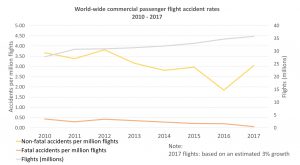Aviation
Airline safety: 2017 was safest year in aviation history.

According to Top70 reports
The past year has been another exceptionally good year for civil aviation safety. With only two fatal accidents to passenger airliners, both involving small turbo-prop planes, 2017 was much better than could reasonably (and statistically) be expected, and was again better than last year’s remarkable performance.
However, the risks to civil aviation do remain high, as the seriousness of some of the non-fatal accidents shows
Airlines recorded zero accident deaths in commercial passenger jets last year, according to a Dutch consulting firm and an aviation safety group that tracks crashes, making 2017 the safest year on record for commercial air travel.
2017 IN REVIEW
Our to70 Civil Aviation Safety Review examines accidents only to larger passenger aircraft commonly used by most travellers. (See our criteria in the Note below.) We include all causes, whether technical failure, human error or unlawful interference. In 2016, there were 71 civil aviation accidents of which six resulted in fatalities. This year, 2017, the number is even lower; 111 accidents, two of which included fatalities. There were no accidents in 2017 related to unlawful interference. A total of 13 lives lost in two regional airline accidents:
- An Embraer Brasilia[1] lost control in flight in Angola after, reportedly, suffering an engine failure, and
- A Czech-built Let 410[2] crashed on landing at Nelken in Russia.
An estimated three percent growth in air traffic for 2017 over 2016 means that the fatal accident rate for large aeroplane in commercial air transport is again reduced; this time to 0.06 fatal accidents per million flights. That is a rate of one fatal accident for every 16 million flights.
With so few fatal accidents to examine, it is worth remembering that there were also several qute serious non-fatal accidents in 2017. A number of engine related accidents occurred, including the spectacular loss of the engine inlet fan and cowling on an Air France A380[3]. That the aeroplane continued to operate safely to a diversion airport and was then flown home for repair on three engines says a lot about the robustness of the aeroplane. In addition to the non-fatal accidents, there are a number of notable events that have been excluded from the statistics. Examples of these accidents include:
In comparison, there were 16 accidents and 303 deaths in 2016 among airliners.
The deadliest incident last year occurred in January when a Turkish cargo jet smashed into a village in Kyrgyzstan as it tried to land at a nearby airport in dense fog, killing 35 on the ground and all four onboard.
The Aviation Safety Network said 2017 was “the safest year ever, both by the number of fatal accidents as well as in terms of fatalities.”
Over the last two decades aviation deaths around the world have been steadily falling. As recently as 2005, there were 1,015 deaths aboard commercial passenger flights worldwide, the Aviation Safety Network said.
The United States last recorded a fatal airline passenger jet crash in February 2009, when Colgan Air Flight 3407 crashed short of the runway in Clarence Center, New York, killing 49 onboard and one person on the ground.
In 2016, 412 people were killed in the United States in aviation accidents – nearly all in general aviation accidents and none on commercial passenger airlines.
The last fatal passenger jet airliner accident worldwide took place in November 2016 near Medellin, Colombia and the last commercial passenger aircraft crash to kill more than 100 people occurred in October 2015 in Egypt.

Aviation
Boeing, Antonov to Collaborate on Defense Projects

– MOU represents Boeing’s commitment to work with Ukrainian industry
– Includes exploring opportunities for collaborating on in-country support of Unmanned Aerial Systems
A Memorandum of Understanding was signed today by Boeing and Antonov Company to investigate potential collaboration on defense-related projects.
“We’re happy to keep collaborating with the Antonov Company to help Ukraine’s economic development and expansion,” stated Ted Colbert, CEO and president of Boeing Defence, Space, & Security.
Airbus and the Antonov An-225: The Best Partnership:Click here
“This agreement demonstrates our ongoing efforts to find more opportunities to work with Ukrainian industry, which was underscored by our signing of the Ukrainian Defence Industry Compact earlier this year.”
The areas of potential collaboration identified in the agreement consist of training, logistical support and overhaul services for tactical Unmanned Aerial Systems utilized by the Ukrainian Armed Forces, which includes the ScanEagle. In addition, the companies will also explore opportunities for Antonov to provide engineering support to Boeing.
The six largest cargo aircraft ever built in the aviation industry:Click here
“A strong, innovative, and efficient defense industry is key to sustainable economic development and national security, and we are extremely excited to collaborate with Boeing,” said Ievhen Gavrylov, CEO of Antonov Company.
This agreement brings a whole new level of opportunity to implement the latest and most effective solutions – in addition to the possibility of future projects with Boeing in the aerospace and defense industry.”
-

 Travel1 week ago
Travel1 week agoAir India to Expand US Operations with Three New Routes After a Decade
-

 Travel2 weeks ago
Travel2 weeks agoWhy We Should Avoid These Stamps in a Passport
-

 Airlines1 month ago
Airlines1 month agoInvestigations Reveal Fake Chinese Titanium in Boeing and Airbus Jets
-

 Tech4 weeks ago
Tech4 weeks agoChina’s CATL Plans 1,800-Mile Electric Plane Launch by 2027
-

 Airport3 days ago
Airport3 days agoTop 10 Largest Airports in the World by Size
-

 Aerospace4 weeks ago
Aerospace4 weeks agoChina’s Fighter Jets Turn Wings into Autonomous Drones
-

 Airlines4 days ago
Airlines4 days agoAir India Rolls Out A350s for Delhi-New York JFK and Newark Routes
-

 Defence3 weeks ago
Defence3 weeks agoBoeing Enhances Chinook with New Engines and Block II Upgrades at $96 Million








